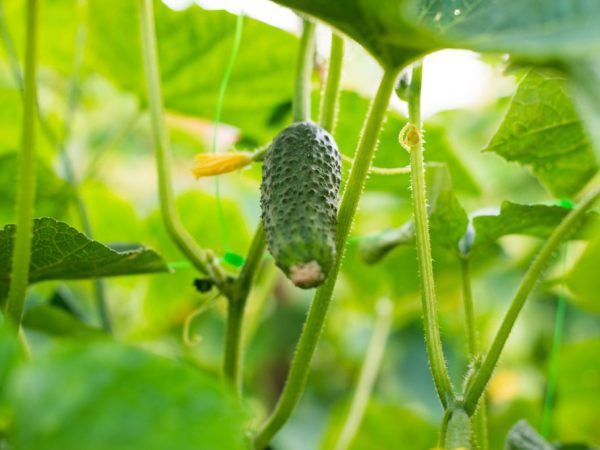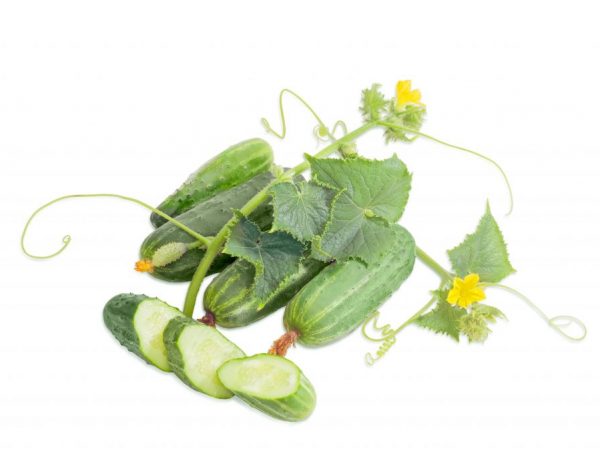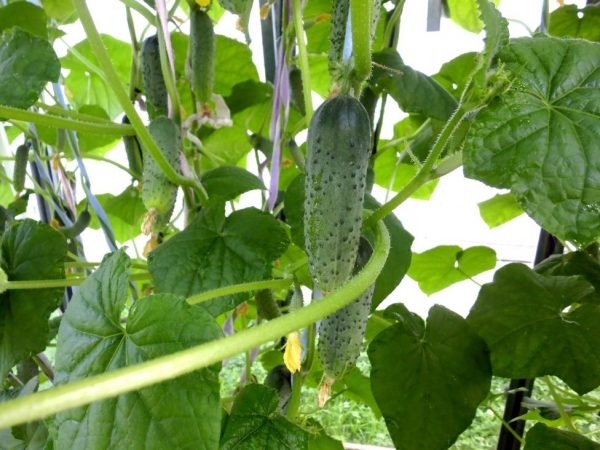Description of varieties of cucumbers with the letter B
Parthenocarpic cucumber varieties are distinguished by their endurance, high yield rates, and do not need pollination. For lovers of traditional varieties, bee-pollinated hybrids are suitable, which are sometimes no worse than parthenocarpic ones. Consider the varieties of cucumbers with the letter B.

Description of varieties of cucumbers with the letter B
Bucks
Bucks cucumber has good seed germination. Begins to bear fruit in 50-55 days. Bucks cucumbers have high taste characteristics. The length of one green leaf, on average, is 25 cm.Their weight reaches 210 g.
Bushes are powerful, branched. The main shoot reaches 3 m in height. The variety pollinated by bees is perfect for growing in open areas and in unheated plastic greenhouses. 7 kg of commercial quality fruit can be harvested from the bush.
Booth
The hybrid variety Balagan f1 is suitable for those who do not have a personal plot. The variety can be grown at home on a balcony or on a windowsill. Plants are drought-resistant, with strong roots, perfectly adapt to shading. Compact sheet plates. Many ovaries are formed in the nodes.
Zelenets looks like a barrel. Length up to 10 cm. The variety not only firmly endures restrictions regarding growing conditions, but also has good immunity. Can be used in fresh diet and canning.
Balalaika
The Balalaika cucumber is a sprint hybrid. The variety is characterized by high yield rates. Pollination type is parthenocarpic. It tolerates most diseases caused by fungal spores.
The surface is medium lumpy. Fusiform shape. The structure of the fruit is firm and crispy. The taste is sweet, without bitterness.
The height of the bush is up to 2.5 m. Fruiting all summer, starting in June. Average yield 12 kg / m2. Recommended landing pattern 50x50,
Boris Borisych
Boris Borisych f1 is a hybrid variety pollinated by bees. It ripens 40-45 days after the first sprouts hatch. The variety is unique in terms of use, cucumbers will be equally tasty pickled and fresh. Zelentsy well retain their presentation, are resistant to mechanical damage.
Cucumber length 12 cm, weight about 110 g. Fruits are cylindrical, slightly elongated. The recommended planting scheme is 50x30.
Squirrel
F1 The squirrel is a plant with limited branching. Bushes actively form lateral lashes, but they can be shortened. The growth point of the main shoot is not limited to the inflorescence. In each internode, from 1 to 3 ovaries are formed. No insects are required for pollination.
Zelentsy are distinguished by their white-pistachio color. Their length is 11 cm. The structure is medium lumpy. The variety is more suitable for various vegetable salads than for pickling.
Brigade
The term of technical maturation of the Brigadny cucumber variety is approximately 55 days. Lined, large tuberous greens with white tips. Length 14 cm, weight 120 g.
In terms of use, it belongs to universal varieties. Perfectly retains its commercial qualities for a long time. Differs in exquisite taste.
Foreman

Variety Brigadier is resistant to diseases
The ripening period of this bee-pollinated hybrid is only 43 days. The foreman is disease resistant. Cultivated equally well in open areas and greenhouse shelters. The recommended landing pattern is 40x40.
Bushes are tall, up to 3.5 m in height. Weave weakly. The surface of zelents is covered with enlarged, sparse tubercles. The taste is sweetish.
La Bella
Cold-resistant species, zoned in the northern regions. La Bella is a parthenocarpic plant. Ripening takes 43 days. Bouquet-type ovaries, each with 4-5 cucumbers.
The fruits do not turn yellow, even if they were not picked from the branches in time. Zelentsy gherkin type, about 6 cm in length. The structure is dense, crispy. They do not lose their qualities for 3-4 weeks, therefore they are perfect for commercial activities.
Pinocchio
The Buratino cucumber belongs to the parthenocarpic species and ripens quickly. Cucumbers are equally good in fresh vegetable salads and canned. Cultivated in film greenhouses and in open areas. The plants are cold-hardy, therefore they are suitable for growing in the northern regions.
Bouquet ovaries. Up to 6 cucumbers are formed in the node. Zelentsy slightly elongated, cylindrical, covered with enlarged tubercles. Their length is 9 cm, with a mass of 100 g. The yield per m2 is 13 kg.
Belmondo
The Belmondo variety ripens for 55-60 days. Refers to parthenocarpic hybrids. The short, cylindrical fruits have a lumpy structure. Fruit length 12 cm. The pulp is firm, sweet, juicy.
Fruiting can be delayed until the very frost. Seedlings tolerate temperature extremes in spring. In the northern regions, it is recommended to use the seedling growing method. Plants do not like too waterlogged soil.
Borovichok
Description of the Borovichok variety:
- high-yielding, bee-pollinated hybrid;
- ripening period is 42-45 days;
- universal in use;
- resistant to fungal diseases, tolerates high humidity well;
- the recommended planting scheme is 40x40.
Bushes are tall, up to 3.5 m. Mandatory garter is required. The cucumbers are covered with tubercles. The pulp is juicy, without bitterness.
Baby mini
Baby mini cucumbers are used in diet food. After the first sprouts have hatched on the 50th day, the fruits reach technical maturity. The flowering type is predominantly female.
Leaves on bushes of compact size, green. Zelentsy have the shape of a cylinder, somewhat reminiscent of a barrel. The weight of the baby cucumber is 160 g.
Butuz

The variety will delight you with an early harvest.
The technical ripening of the Butuz variety is 42 days. The bushes are weakly branched. The flowers are female. The foliage is medium-sized, green.
Zelentsy are shortened, oval-cylindrical in shape. Painted green, with slightly pronounced stripes of a lighter shade. The structure is tuberous, the pubescence is white.
Bjorn
Self-pollinated variety Björn is perfect for outdoor and indoor cultivation. The bushes are compact, with a powerful rhizome. The foliage is not too densely planted. Lateral shoots are shortened.
Gherkin-type cucumbers reach a length of 10 cm. The flesh is crispy, sweet, without bitterness. In terms of use, it is considered a universal variety.
Benefit
Parthenocarpic early ripening hybrid Benefis has a high yield, about 8 kg of cucumbers per m2. Ripening period is about 50 days. The variety is recommended for growing in open / closed ground, the optimal step between the bushes when planting is 50 cm.
Cucumbers are in the shape of a cylinder. Their surface is covered with small frequent tubercles. Excellent taste and quality indicators allow using the fruits in salads and for winter preparations.
Bochkova
Ideal for pickling and pickling.The barrel cucumber boasts the highest taste. He is completely free of bitterness.
Plants are practically immune to disease. Technical maturity occurs in 40 days. Recommended for planting in greenhouses, but also in the open field gives good yields.
Bimbo old
Characteristics of the Bimbo Star variety:
- early ripening cucumbers with parthenocarpic pollination;
- laying of bundle-type ovaries;
- bushes indeterminate, strongly weaving;
- foliage is medium-sized.
Cucumbers are cylindrical in shape. Their weight is about 75 g, and the length is 7-10 cm. When grown in film shelters, the yield per m2 is 9 kg.
Brother Ivanushka
The bee-pollinated variety of cucumbers, Brother Ivanushka, ripens for 45-50 days. Bushes are indeterminate, branching weakly. In inflorescences, most flowers are female.
Cucumbers are small in size, up to 9 cm in length, weighing about 100 g. Their surface is covered with small tubercles with black fluff. The taste is sweet, without a hint of bitterness.
Bonus

Bonus fruits are devoid of bitterness
High-yielding hybrid Bonus F1 refers to early maturing varieties. Differs in high resistance to all kinds of diseases typical for cucumber crops. Begins to bear fruit in greenhouse conditions in May, outdoors at the end of June.
Bushes of medium height, about 2 m. Bunch-type ovaries. The fruits are crispy, juicy, without a hint of bitterness.
Bystrenok
Parthenocarpic variety Bystrenok has a short ripening period, about 35 days. The ovaries are formed in bunches, 3-5 fruits each. The yield per m2 is 17 kg.
Zelentsy are distinguished by their beautiful cylindrical shape. Their surface is covered with small bumps. The fruits retain their presentation for 2 weeks. By type of use, they are referred to as universal varieties.
Babayka
The Babayka variety ripens for 1.5-2 months. Ovary type is bouquet. The plant is vigorous, lateral shoots are limited in growth.
Cucumbers are elongated, oval. The average length of the greenery is 14 cm. The peel is thin, dark green, covered with tubercles. The taste is sweetish, without bitterness.
Bedretta
The ultra-ripe hybrid of Bidrett bears fruit 25-30 days after sprouting. The seeds are distinguished by good germination. From m2 you can get 4-5 kg of excellent crispy greens.
Plants are completely unpretentious to care for. Resistant to many diseases. Pollinated by insects.
The length of marketable greenery is 18 cm. The surface is slightly lumpy, waxy. Weight does not exceed 120 g. The pulp is juicy, has a pleasant aroma and taste.
Barvina
Dutch hybrid Barvin was bred in 2008. The variety does not need pollination. Bushes of medium height, indeterminate, with limited growth of lateral shoots.
In each node, 2 ovaries are formed. Zelentsy are elongated-oval. The skin is dark green with short stripes of light green. The thorns are white. The pulp on the cut is light green, has a pleasant taste and aroma.
Conclusion
Among the varieties of cucumbers with the letter B, any gardener will find a variety to his taste. Many of the varieties are suitable for growing not only in greenhouses and open field, but also on windowsills. All varieties can be planted by seedling and seedling, depending on climatic conditions.
Before sowing seeds, read the manufacturer's instructions carefully. Many varieties are already sold as treated with fungicides and growth promoters and therefore do not require additional soaking.


